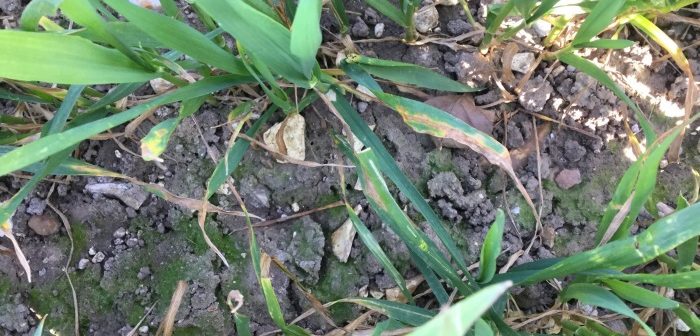With the UK experiencing major regional variations in cereal disease risk, independent AICC agronomist David Lines provides a view from the west while Dave King, head of technical at Syngenta provides an update from their trial sites around the rest of the country.
Generally, crops are really starting to grow on, and they don’t look too bad despite the drought conditions, but there is still a lot of disease there, explains David Lines.
“On the 5,000 hectares I’m walking in North Herefordshire, we’re lucky to have deep soils so the dry weather isn’t currently having the same negative impact on crops as other areas and they’ve rooted well. However, where I’ve got farmers on lighter land, crops are really starting to show signs of drought stress,” he adds.
“Timings are on track, leaf 3 is 80% emerged and T1 sprays are going on from the 19 April onwards, apart from some very early varieties such as Lili that went on a couple of weeks ago.
“The season is all over the place in this respect, there are major variations depending on variety, soil type, and drilling date; even within my patch.
“Generally, leaf 4 is clean but leaf 5 is carrying disease and is something to keep an eye on, especially as leaf 6, 7, and 8 are still there on earlier drilled crops. This can really harbour and spread disease up the plant if you don’t manage the risk properly,” says Mr Lines.
“We’re regularly seeing a heavy dew and while crop walking you’ll see leaves moving and touching so there is plenty of chance for disease inoculum to spread, and once it starts cycling, things can change very quickly.
“We want T1 to act as a disease barrier for leaf 2, so we’re now using a much more robust T1, but the main spend is still reserved for T2.
“For T2 you’re really looking for a powerful, persistent SDHI fungicide that offers good all-round disease control, with some degree of kick back. You want a product that will keep you on track,” says Mr Lines.
Elatus Era is a new SDHI on the market that has proven its persistency in trial work. “It will be a sensible T2 solution that offers that all-round control and we know it’s reliable on rust. We’ll be looking to use it on Reflection, for example.
“If I knew the forecast for the next couple of months, it would be very easy, but as we don’t we have to manage the known risk, and ensure we protect against the disease that is there.”
Dave King explains that there is definite variation in disease levels and it is very variety-dependant, but region and weather plays a big part in it.
“Our Syngenta Innovation Centres and Platform trial sites are spread the length and breadth of the country and that provides us with a very real picture of how things are progressing for growers.
“For example, up on our York Innovation Centre, we’re seeing a real mixed bag of disease on winter wheat which is very dependent on the variety. There was yellow rust on Lili before T0’s went on, and we’re still seeing yellow rust in the less resistant varieties. Septoria is also proving easy to find and there are signs of mildew in untreated plots.
“Across in Market Stainton, Septoria is easy to find on lower leaves of all wheat varieties. This really highlights the need to create a protectant disease break.
“This is also the case in Newark, despite it being extremely dry. Leaf 3 is fully emerged in some cases, but even the later varieties are still up to 50% emerged. The barley plots at Newark are also really moving through the growth stages, and lodging could be an issue if you’re not careful,” says Mr King.
“Despite the very dry season we’re seeing at present, you still can’t be too complacent as it’s all about managing risk. As we move towards the critical T2 timing, using a robust, persistent SDHI that you know is going to protect the crops will mean you’re covered when things do change.”




